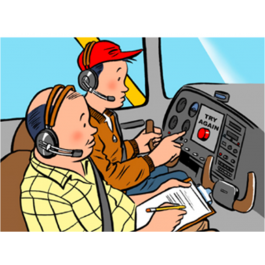|
|
Commercial Pilot Practical TestDescriptionCommercial Pilot Practical Test / Plan Of Action Revised October 3 2025>>>>>>>>>>WINGS ACTIVITIES<<<<<<<<<< These activities can be used for passing your commercial pilot checkride ASEL-Commercial Maneuvers and Navigation (Pvt, Comml, ATP) - Activity Number:A100126-79 And use ASEL-Takeoffs, Landings, Go-arounds (ATP, Comm'l, Pvt) Advanced Level - Activity Number:A070405-89 You can also use this flight activity Initial Certification - Commercial Pilot Activity Number:A071102-01 Here are the Wings credits for Part 141 applicants for passing your checkride. Activity Number:A071102-01-141 141 Ground School Activity Number:A110520-02 These Wings activities can be used/earned while doing your training for your commercial pilot certificate. ATC & You: The Art of Negotiating with ATC ASEL - Takeoffs, Landings, and Go Arounds Wings Activity - A070405-07 Laps In The Traffic Pattern FAA Wings Activity - EducAvia-PVT-ASEL-001 ASEL-Airport Operations (Pvt, Comm'l, ATP) - Activity Number:A100125-07 ASEL-Takeoffs, Landings, Go-arounds (ATP, Comm'l, Pvt) Advanced Level - Activity Number:A070405-89 IMPORTANT NOTES: You need 10 hours of instrument time logged per 61.129 i. Just because you have an instrument rating, does not mean that you have the 10 hours of instrument time required for the commercial certificate. The instrument time and the maneuvers needs to be logged in your logbook. See links below for more info. You NEED to have GROUND TIME LOGGED in your logbook. The notes below, pertain to the instrument rating, however; they can affect your requirements for the commercial certificate. The long IFR cross country CANNOT be used for the two dual commercial cross countries. You CANNOT use student pilot solo cross country time towards the 50 hours of cross country requirement for the instrument rating. You CANNOT log cross country time if you are acting as a safety pilot. If you have received flight training from me and would like to leave feedback in AOPA's Flight Training Survey, see the link below. Step by step Incorporate test codes into my Commercial Pilot Plan Of Action Print Flight-Profile to take on flight The day of the test: Verify that the applicant has the required hours and experience. Click here for Part 61 requirements *****NOTE***** An applicant for the Commercial Pilot Practical Test must have the instrument time logged per 61.129 i. Just having the instrument rating, does not necessarily mean that the applicant has the required instrument time. This instrument training must have been given by a CFII, per March 2021 DPE class and FAA policy. Verify approval for test in DMS Verify proper endorsements for checkride: A 1. I certify that [First name, MI, Last name] has received and logged training time within 2 calendar-months preceding the month of application in preparation for the practical test and [he or she] is prepared for the required practical test for the issuance of [applicable] certificate. A 2. I certify that [First name, MI, Last name] has demonstrated satisfactory knowledge of the subject areas in which [he or she] was deficient on the [applicable] airman knowledge test. A 34. I certify that [First name, MI, Last name] has received the required training of § 61.125. I have determined that [he or she] is prepared for the [name of] knowledge test. A 35. I certify that [First name, MI, Last name] has received the required training of §§ 61.127 and 61.129. I have determined that [he or she] is prepared for the [name of] practical test. Open the proper ACS Open my Questions & Answers page PUNCH HOLE IN OLD CERTIFICATE Open FAA checklist for the DPE Here is my page for the ACS documents Here is my question and answer page When the applicant is with you for the practical test and they are reviewing the online 8710, you the examiner should take control and be sure that the applicant accepts each page and does not just close each page. This is very important. Take control of this and guide the applicant through this process. Print the Knowledge Test from IACRA and compare the numbers with the original. After reviewing the 8710 in IACRA, you have a chance to return the 8710 to the applicant to correct any issues. Have the applicant sign a printed 8710 in front of you. This is for your file. In IACRA, explain in detail in the remarks/comments section any special issues. Also in this section you can explain exactly why an applicant failed so that the next examiner has the details. You can start each checkride with the PAVE and I'M SAFE checklist. At the completion of the checkride, the DPE will keep the original test results. You return the original only if you discontinue the test or the applicant fails the test. *******Notes >>>>> Per the March 2019 Initial DPE training class an applicant can do one or two go arounds when attempting a landing. It is up to the examiner as to how many go arounds are allowed. >>>>> An applicant can also stop a maneuver and restart it if the applicant feels the maneuver got of to a bad start. For example, on a steep turn if the applicant is climbing or descending too much during the entry, the applicant can stop the maneuver and restart the maneuver. Lazy Eight - On a lazy eight ask the applicant to state their heading, altitude, and airspeed at the beginning of the maneuver and then ask them to state their heading, altitude, and airspeed at the end of the maneuver. If they are not within the ACS tolerances, the applicant has just told you that the maneuver was not completed per the ACS and therefore the Area Of Operation or Task was unsuccessful. *****Note >>>>> The FAA does not recommend that you do a touch and go on a Practical Test. *****Note >>>>> Power Off 180 - Per a March 2019 DPE training class, a go around on this maneuver is not allowed. If the applicant see that he/she will not make the spot, the Area Of Operation is unsatisfactory. PracticalTest PlasticCertificate Detailed Information |










